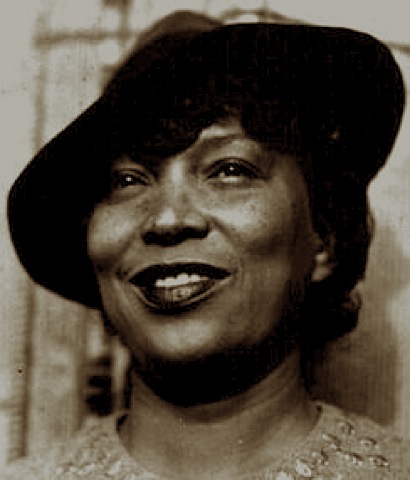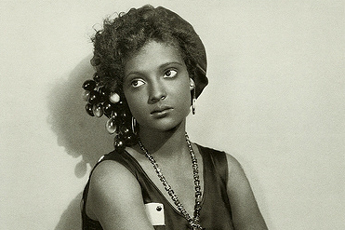Part of Vintage Viewing, exploring the work of female filmmaking pioneers.

“Mama exhorted her children at every opportunity to ‘jump at the sun.’ We might not land on the sun, but at least we would get off the ground. ” – Zora Neale Hurston
The seven principles of Kwanzaa (Nguzo Saba), designed to foster community empowerment in the face of racial stigma, include Kujichagulia, the right to “define ourselves, name ourselves, create for ourselves and speak for ourselves.” Though we often debate choice of imagery on Bitch Flicks, it is impossible to create an image that represents another group’s equality, because their right to define their own image is fundamental to that equality. Caribbean-American comedian Bert Williams became the first Black artist to write, produce, direct and star in a film, with 1916’s A Natural Born Gambler, having already broken boundaries as writer-star of In Dahomey (1902), the first Black musical on Broadway. Williams’ performances exploited the blackface conventions of his age to be acceptable to a wider audience, while illuminating them with humanity and subversive subtext, as he continually fought for greater creative control. At the climax of A Natural Born Gambler, his character plays an imaginary poker game in prison. By losing, even in his own fantasy, Williams makes virtuoso mime into poignant commentary on internalized stigma, also the theme of his hit song, “Nobody,” from the 1906 musical Abyssinia. The same year, Williams’ Fish cast himself, then in his 40s, as a young boy who escapes his chores to catch fish and is punished for his entrepreneurship. In a society where even Black children were often viewed as prematurely adult, Williams’ demand that audiences recognize the child in the man was challenging, and audiences reacted unfavorably. Neither of Williams’ surviving films feature significant roles for women.
[youtube_sc url=”https://www.youtube.com/watch?v=naUN5L56Zg4″]
Bert Williams masked biting commentary under comic delivery
In 1920, Oscar Micheaux wrote and directed Within Our Gates, the oldest surviving feature film by a Black director. The film argues for education and against the unquestioned domination of the church, while breaking many taboos, including depicting a lynching and the attempted rape of a Black woman by a white man. However, its heroines remain stilted and rigidly defined by Madonna/Whore framing. Micheaux’s 1925 film, Body and Soul, features a powerful performance by Mercedes Gilbert as a rape victim, opposite a menacing debut by Paul Robeson. Yet, the heroine must demonstrate her virtue by dying of shame, harnessing the martyrdom of the female body to score Micheaux’ points about oppressive religious hypocrisy. 1910’s White Fawn’s Devotion by James Young Deer (the Nanticoke director of 34 Westerns, whose role in shaping the genre is rarely acknowledged), uses the martyred suicide of White Fawn to prove to her Euro-American husband that she is attached to homeland and kin, once more scoring its racial points through female martyrdom (even if the heroine recovers for a happy end).

“As long as the plays are being written and produced by whites for whites, there will be the same chance for criticism. The only remedy is for such plays as would meet popular favor to be produced by us.” – Louise Beavers
Mabel Normand‘s star vehicle, Mickey, featured sympathetic scenes of bonding between Mickey and her foster mother, played by Cheyenne comedienne Minnie Devereaux, while Mae West’s films showed extensive, sympathetic banter with maids played by Louise Beavers (whose performance in Imitation of Life was acclaimed as Oscar-worthy, without promoting Beavers from supporting roles) and Soo Yong (cast as aunt to a yellowface protagonist in The Good Earth). Though these displays of interracial female solidarity by Normand and West would be considered progressive for their time, they limit women of color to supporting roles, reinforcing their heroines’ white supremacy. The fact that white female filmmakers tended to reinforce white supremacy with their representations, while male directors of other races utilized disempowering sexist tropes, surely illustrates why they cannot collectively represent women of color.
As Deborah Riley Draper points out in her Bitch Flicks post, “#EarlyCinemaSoBlack,” many Black women were striving to bring their perspectives to the screen at this time. Tressie Souders became probably the first Black woman to write and direct a film with A Woman’s Error in 1922, but her film is now lost. However, considering how Chinese-American writer-director Marion Wong’s 1916 feature, The Curse of the Quon Gwon: When the Far East Mingles With The West, turned up unexpectedly in a basement in 2005, Souders’ film might yet be similarly rediscovered. Wong showcased traditional Chinese ceremonies to satisfy Western curiosity about the exotic Orient, but she also explored Chinese-American cultural tensions with the nuance of an insider. The Curse of the Quon Gwon uses superimpositions and dissolves in a short fantasy sequence to represent the heroine’s own imagination, predating similar effects by Germaine Dulac. It’s worth remembering that Dulac made a series of conventional films before developing the impressionist and surrealist styles that she is celebrated for, while The Curse of Quon Gwon was Marion Wong’s only film (denied financing, distribution or promotion, despite her striving to secure them). With the same support as Dulac, how far could Wong have developed, described by the Oakland Tribune as “energy personified”?
[youtube_sc url=”https://www.youtube.com/watch?v=xAxpLXP6O_M”]
Where they did not face the stigma of a racial minority, women of color found more filmmaking success. In India, Fatma Begum directed the first of eight fantasy epics in 1926. The following decade, Sakane Tazuko became the first female director in Japan, while Elena Sánchez Valenzuela directed a feature documentary in her native Mexico, acclaimed by journalists for “hundreds of the most beautiful, evocative scenes” but now lost. Esther Eng began writing and directing in Hong Kong in 1937 (documentary clip). Still, the ethnographic films of Zora Neale Hurston remain a rarity: vintage footage directed by a woman of color, available online. Better known as the playwright of 1925’s prize-winning Color Struck, as a leading light of the Harlem Renaissance, and as the author of novels including Their Eyes Were Watching God (see Bitch Flicks‘ review of Darnell Martin’s adaptation), Hurston also studied anthropology under Dr. Franz Boaz, who dedicated his life to challenging assumptions of Western cultural superiority. Believed to be part of Hurston’s wider research into African-American folklore, these ethnographic films were made in the Southern United States between 1928 and 1929. The footage is scored in the embedded video with Hurston’s own performance of folk songs that she collected. At first glance, her films seem like simple anthropological records. However, they are equally revealing when read as explorations of our ways of seeing, framing and interpreting others.
Logging (1928) – Children’s Games (1928) – Baptism (1929)
“She pulled in her horizon like a great fish-net. Pulled it from around the waist of the world and draped it over her shoulder. So much of life in its meshes!” – Zora Neale Hurston
The Palestinian-American founder of postcolonialism, Edward Said’s Orientalism explored how the psychological needs of the observer shape their observations, as much as the nature of the thing observed. Criticizing the constant framing of “things Oriental in class, court, prison or manual for scrutiny, study, judgment, discipline or governing,” Said noted that imperial observers tended to interpret the Orient through “synchronic essentialism,” as something fixed and unchanging. Essentialist interpretations deny responsibility: if something is unchanging, it is impossible for oppression to impact it. If women are essentially and eternally nags, you aren’t responsible for your wife’s annoyance. If colonized people are hotheaded savages, they need no reason for rebellion. If dispossessed peoples are permanently lazy, it isn’t a symptom of their demoralizing dispossession. Oppressors become invisible to themselves through their interpretative framework.
Fictions of objective and invisible observers (oppressors?) are the traditional framing of anthropology. A “native” may be scowling because the photographer is intrusive, but their image will be frozen as an “objective” record of the “hostile native”, with viewers instinctively imagining themselves in the photographer’s place. Robert Flaherty’s Nanook of the North charmed audiences with its warm intimacy, popularizing the art of the documentary feature. But by claiming objectivity and obscuring his sexual relationship with his subjects, however, Flaherty distorted their shared banter and flirtation into essentialized features of the “happy-go-lucky Eskimo” and his “smiling one” wife, fueling a popular image of Inuit naivete and availability.
In her ethnographic films, Hurston, by contrast, strikingly resists fictions of objectivity and pointedly draws attention to herself as observer. A woman and a dancing child smile directly into her lens in extreme close-up, with shy pride or beaming pleasure at her clearly encouraging attention. Instead of merely observing their games, we join the circle of clapping children and they interact with the camera as it pans over their faces. Hurston’s camera is dynamic, tracking up a logging railway and lingering on tapping feet. We instinctively warm to her subjects, as we share Hurston’s sense of belonging through her camera’s gaze. She contrasts the work of an elderly lumberjack with the machinery of professional logging, showing a world of changing realities, and lingers on sawmill workers’ leisure rather than fetishizing their labor, casually noticing a woman among them. Is their mechanized modernity an improvement on the old man’s axe?

“She had an inside and an outside now and suddenly she knew how not to mix them.” – Zora Neale Hurston
Of most interest for questions of self-representation, Hurston briefly portrays woman’s life in the community. Opening with the woman framed against her home environment, a wooden cabin, in the pose of a typical anthropological subject, Hurston’s woman then holds our gaze purposefully and walks up close. Hurston instructs her to smile, turn and present her profiles; she is reframed as a model, or an actress on a casting call. Compare Faith Ringgold‘s “Picasso’s Studio”: her nude heroine models against a backdrop of African “primitivism” that has been reframed by Picasso as “modernism,” while Ringgold playfully reframes Picasso himself in the African-American, feminine “folk art” of quilting, challenging the gendered and racialized ways art is interpreted and (de)valued, just as Zora Neale Hurston challenges the devaluing subtext of the anthropological frame through glamor modeling. As Hurston cuts to her woman sitting with another woman on the porch, laughing in each other’s company, this is surely the silent film equivalent of a Bechdel pass. Bouncing to a wide angle on the cabin environment, the next shot reframes the woman again, draping her over her porch railing in the “Venus reclining” pose. Hurston’s use of this classical pose recalls the 19th century African-American/Ojibwa sculptor Edmonia Lewis‘ use of Classical Grecian styles to visually code her African and Indigenous subjects as noble. From this static pose, Hurston cuts to the woman’s feet tapping as she rocks, adding musical sensibility. Hurston has thus reframed her subject five times: 1) as a product of her environment, 2) as a glamorous beauty, 3) within a community of female friendship, 4) as an iconic goddess and 5) as an appreciator of music. In total silence, in under a minute and with a mediocre camera, Hurston achieves a multi-faceted portrait. Imagine what she could have done with a budget and a distributor.
[youtube_sc url=”https://www.youtube.com/watch?v=wtPrN-zYZc4″]
The world’s first animated feature film, 1926’s The Adventures of Prince Achmed, was a celebration of Middle-Eastern folklore, animated by Lotte Reiniger. Reiniger’s concept, for creating feature-length animations based on classic folklore, would become box office gold for Walt Disney, winning him a special Oscar for innovation, while he also patented a design for a multi-plane camera almost identical to Reiniger’s. Despite his debt to Lotte Reiniger, Disney would exclude women from creative work in his company. Next month’s Vintage Viewing: Lotte Reiniger, Animating Innovator. Stay tuned!
Brigit McCone writes and directs short films and radio dramas. Her hobbies include doodling and learning new things.










